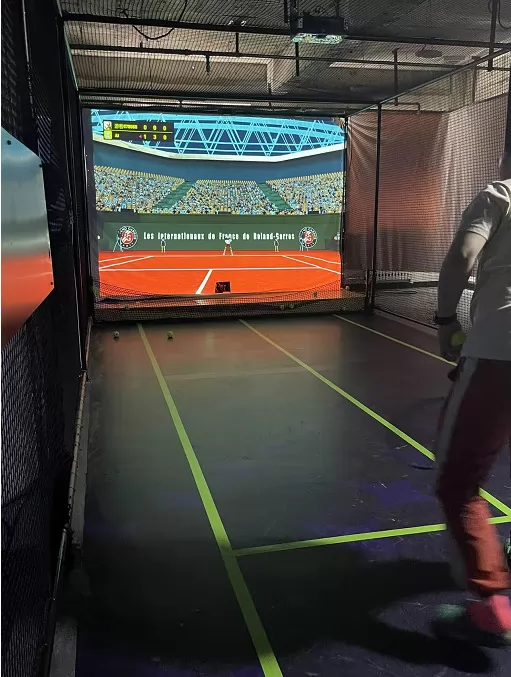In the rapidly advancing world of virtual sports games, the fusion of digital technology and traditional sports has created an exciting new frontier for enthusiasts and gamers alike. From immersive go-kart racing to interactive basketball, these games provide an unparalleled blend of physical activity and digital interaction. Whether you're looking to enhance your skills, engage in friendly competition, or simply experience the thrill of cutting-edge technology, our guide to the best 5 virtual sport games offers something for everyone. Join us as we explore the top contenders in this dynamic and innovative field.
- Sports simulators are constantly improving
- The combination of sports and technology is becoming more and more popular
- Gamification and virtual sports are becoming more and more popular
- Why are these virtual digital sports games becoming more and more popular?
- Advantages of virtual sports games
- Disadvantages of virtual sports games
-
Best 5 Virtual Sport Game
- Immersive Go Karting
- Interactive Tennis
- Interactive Basketball
- Interactive Archery
- Interactive Football
1.Sports Simulators Are Constantly Improving
The realm of virtual sport games is ever-evolving, driven by advancements in technology that continuously refine and enhance the experience. Modern sports simulators are far from the basic pixelated versions of the past. They now boast high-definition graphics, realistic physics, and immersive environments that replicate real-life sports scenarios with remarkable accuracy.
These digital sport games have gained popularity not only among casual gamers but also within professional sports communities. Athletes and trainers alike use these sophisticated simulators to practice techniques, analyze performance, and strategize for actual competitions. The realism offered by current sports simulators allows for a deeper level of engagement and training that was once only possible on a real field or court.
Continuous improvements in virtual reality (VR) and augmented reality (AR) technologies are pushing the boundaries of what’s possible in virtual sport games. These advancements ensure that users can experience the sensation of being in a stadium or on a racetrack, complete with the intricate details of real-world environments and dynamics. The integration of haptic feedback and motion tracking further enhances the realism, allowing players to feel every movement and impact as if they were actually participating in the sport.
Moreover, the software driving these digital sport games is becoming increasingly sophisticated. AI-powered algorithms can analyze a player’s style and offer personalized feedback and challenges, making each session uniquely tailored to the user’s abilities and goals. This personalization not only improves the gaming experience but also helps in honing specific skills more efficiently.
As we continue to see advancements in technology, the potential for sports simulators to revolutionize both the gaming and sports training industries becomes increasingly apparent. The blending of reality and digital worlds is not just a trend but a transformative shift that is reshaping how we engage with sports and physical activity. The future of virtual sport games looks bright, with endless possibilities for more dynamic and interactive experiences.
2.The Combination of Sports and Technology Is Becoming More and More Popular
In today’s digital age, the convergence of sports and technology is revolutionizing the way we engage with physical activities. The synergy between these two domains has given rise to a new genre of entertainment and training—digital sport games. As these technologies advance, the appeal and adoption of virtual sport games have surged, creating a dynamic intersection where the physical and virtual worlds seamlessly blend.
One of the driving forces behind this growing popularity is the accessibility and inclusivity that sports simulators offer. These platforms provide opportunities for individuals who might not have access to traditional sports facilities or those who face physical limitations, allowing them to experience and enjoy the thrill of various sports. From the comfort of their homes, users can engage in activities ranging from football to skiing, all through a screen and a set of controls.
Furthermore, the integration of technology into sports has not only enhanced the gaming experience but also opened up new avenues for learning and skill development. Virtual sport games offer detailed analytics and feedback, enabling players to track their performance and progress over time. This data-driven approach helps in refining techniques and strategies, making it a valuable tool for both amateur enthusiasts and professional athletes.
The rise of esports has also contributed to the burgeoning popularity of digital sport games. Competitive gaming tournaments now attract millions of viewers and participants worldwide, showcasing how virtual versions of traditional sports can generate excitement and engagement on a massive scale. The integration of high-definition graphics and real-time streaming technology has transformed esports into a global phenomenon, further blurring the lines between digital and physical sports.
Additionally, advancements in technology have enabled the creation of more immersive and realistic sports experiences. Innovations such as motion sensors, VR headsets, and augmented reality have elevated the gaming experience, allowing players to interact with their virtual environments in unprecedented ways. These technological enhancements provide a level of immersion and realism that was previously unimaginable, making sports simulators a captivating option for both entertainment and training.
As technology continues to evolve, the combination of sports and technology will likely become even more intertwined, driving further growth in the virtual sport games market. This trend reflects a broader cultural shift towards digital engagement and highlights the potential for technology to enhance our physical activities and sporting experiences. Whether for fun, fitness, or professional development, the integration of sports and technology offers endless possibilities and continues to captivate audiences around the world.
3.Gamification and Virtual Sports Are Becoming More and More Popular
In the rapidly evolving landscape of digital sport games, the concept of gamification has emerged as a key trend, significantly boosting the appeal and engagement of virtual sports. By integrating game design elements and principles into sports activities, gamification has transformed the way we interact with and perceive sports, making them more accessible, engaging, and enjoyable for a broader audience.
Gamification involves the application of game mechanics such as points, leaderboards, and rewards to non-game contexts, in this case, sports. This approach has proven to be highly effective in motivating individuals to participate in physical activities, as it adds an element of fun and competition. Through sports simulators, users can now engage in virtual sports that offer real-time feedback and rewards for performance, creating a compelling and immersive experience.
One of the primary reasons behind the rising popularity of gamification in virtual sports is its ability to make sports more engaging and interactive. Traditional sports often require a significant commitment of time, physical effort, and resources, which can be a barrier for many individuals. In contrast, digital sport games can be accessed anytime and anywhere, allowing players to enjoy their favorite sports without the limitations of physical location or equipment.
Moreover, gamification leverages the psychological appeal of competition and achievement. Players can track their progress, set personal goals, and compete with others on virtual leaderboards. This not only enhances the sense of accomplishment but also encourages continued participation and improvement. The immediate feedback and rewards system in virtual sports games provide a sense of gratification that traditional sports may not always offer.
The fusion of gamification with virtual sports has also opened up new possibilities for learning and skill development. For instance, simulation games can mimic real-world sports scenarios, allowing users to practice and hone their skills in a safe and controlled environment. This is particularly beneficial for beginners and young athletes who can learn the basics and develop their techniques without the risk of injury or the pressure of real-world competition.
Furthermore, the rise of social and mobile gaming has expanded the reach of virtual sports. Platforms like smartphones and tablets make it easy for users to engage with sports games on the go, while social features such as multiplayer modes and online tournaments foster a sense of community and shared experience. This has led to a surge in popularity for digital sport games that combine the excitement of gaming with the benefits of physical activity.
In conclusion, the growing trend of gamification in virtual sports is reshaping the landscape of sports and gaming. By making sports more accessible, enjoyable, and rewarding, gamification is not only encouraging more people to participate in physical activities but also transforming the way we experience sports. As technology continues to advance, the integration of game mechanics into digital sport games will likely become even more sophisticated, further enhancing the appeal and impact of virtual sports.
4.Why Are These Virtual Digital Sports Games Becoming More and More Popular?
The increasing popularity of virtual sport games and digital sport games can be attributed to several compelling factors that resonate with a diverse audience. These games offer a unique blend of accessibility, engagement, and technological innovation that traditional sports struggle to match. Here’s a closer look at why these virtual sports experiences are capturing the attention of so many people around the world.
1. Accessibility and Convenience
One of the primary reasons for the popularity of virtual sport games is their accessibility. Unlike traditional sports, which often require specific equipment, locations, and conditions, virtual sports can be played anywhere, anytime. Whether you’re at home, in the office, or on the go, all you need is a compatible device and an internet connection. This convenience makes it easier for people to incorporate sports into their daily routines without the logistical challenges associated with physical sports.
2. Cost-Effective Entertainment
Engaging in traditional sports often involves significant costs, including equipment, memberships, and travel. In contrast, digital sport games typically require a one-time purchase or a subscription fee, making them a more affordable option for many. This cost-effectiveness, combined with the extensive variety of sports available, allows users to explore different activities without the financial commitment of traditional sports.
3. Engaging and Interactive Experiences
The interactive nature of virtual sport games is another key factor driving their popularity. These games are designed to be highly engaging, with realistic graphics, immersive environments, and dynamic gameplay that keeps users entertained for hours. The use of motion sensors, VR headsets, and other advanced technologies enhances the level of immersion, making players feel as though they are actually participating in the sport.
4. Physical and Mental Benefits
Beyond entertainment, virtual sport games offer a range of physical and mental health benefits. These games can serve as an effective form of exercise, helping players stay active and improve their fitness levels. Additionally, the cognitive challenges presented by many digital sport games can enhance mental agility and problem-solving skills. The combination of physical movement and mental stimulation makes these games a valuable tool for maintaining overall well-being.
5. Social Connectivity and Community
The social aspect of virtual sport games cannot be overlooked. Many of these games feature multiplayer modes and online communities that allow players to connect with others, compete in tournaments, and share their experiences. This social connectivity fosters a sense of community and belonging, which is particularly important in today’s digitally connected world. The ability to engage with friends and meet new people through gaming adds an extra layer of enjoyment and motivation.
6. Technological Advancements
The rapid pace of technological advancement is continually pushing the boundaries of what’s possible in digital sport games. Innovations in graphics, artificial intelligence, and interactive technologies are making these games more realistic and captivating than ever before. As technology continues to evolve, we can expect even more sophisticated and engaging virtual sports experiences that will attract an even larger audience.
In summary, the growing popularity of virtual sport games and digital sport games is driven by a combination of accessibility, affordability, interactivity, health benefits, social engagement, and technological innovation. These factors collectively make virtual sports an appealing and viable alternative to traditional sports, offering a modern way to stay active, connect with others, and enjoy the thrill of competition.
5.Advantages of Virtual Sports Games
The rise of virtual sport games has brought numerous advantages, making them a popular choice for both casual players and serious enthusiasts. From enhanced accessibility to innovative training opportunities, these games offer a range of benefits that traditional sports cannot always provide. Let’s delve into the key advantages of embracing digital sport games.
1. Accessibility and Inclusivity
One of the most significant advantages of virtual sport games is their accessibility. Unlike traditional sports, which may require specific facilities, equipment, or geographic locations, virtual sports can be enjoyed by anyone with access to a computer, gaming console, or mobile device. This inclusivity allows individuals of all ages, backgrounds, and physical abilities to participate and enjoy the benefits of sports without any barriers.
2. Cost-Effective Solution
Engaging in traditional sports often involves significant financial investments, including the cost of equipment, memberships, and travel expenses. In contrast, digital sport games offer a cost-effective alternative. The initial cost of purchasing a game or subscribing to a service is typically much lower than the ongoing expenses associated with traditional sports. This affordability makes virtual sports an attractive option for individuals and families looking to enjoy sports without the high costs.
3. Safe and Controlled Environment
Safety is a paramount concern for many people when it comes to sports. Traditional sports can pose risks of injury, particularly for beginners or those not in peak physical condition. Virtual sport games, on the other hand, provide a safe and controlled environment where players can practice and enjoy sports without the risk of physical harm. This aspect is particularly beneficial for children, older adults, and individuals with physical limitations.
4. Flexibility and Convenience
The flexibility of virtual sport games is another major advantage. Players can enjoy their favorite sports anytime and anywhere, fitting their gaming sessions into their busy schedules. This convenience is a significant draw for people who may not have the time or resources to commit to regular participation in traditional sports. Additionally, the ability to pause and resume games at any time allows for greater flexibility in how and when players engage with their favorite sports.
5. Skill Development and Training
Digital sport games offer unique opportunities for skill development and training. Through realistic simulations and interactive gameplay, players can practice and refine their skills in a variety of sports. These games often provide detailed feedback and performance metrics, allowing players to track their progress and identify areas for improvement. For aspiring athletes and enthusiasts, virtual sports serve as an invaluable tool for honing their abilities and gaining a competitive edge.
6. Social Interaction and Community Building
The social aspect of virtual sport games is another key advantage. Many of these games feature multiplayer modes and online communities where players can interact, compete, and collaborate. This social interaction fosters a sense of community and camaraderie, allowing players to connect with others who share their interests. Whether through friendly matches or competitive tournaments, virtual sports provide a platform for socializing and building lasting relationships.
7. Continuous Innovation and Updates
The world of virtual sport games is constantly evolving, with developers continually introducing new features, updates, and technologies. This continuous innovation ensures that the games remain fresh, exciting, and engaging for players. From enhanced graphics and more realistic physics to new game modes and challenges, the ongoing development of digital sports games keeps players coming back for more, eager to explore the latest advancements and experiences.
8. Environmental Benefits
Finally, virtual sport games offer environmental benefits by reducing the need for physical infrastructure and resources associated with traditional sports. There is no requirement for large sports facilities, transportation, or equipment manufacturing, all of which can have significant environmental impacts. By embracing digital sports, players can enjoy their favorite activities in a more sustainable and eco-friendly manner.
In conclusion, virtual sport games offer a wealth of advantages that make them an attractive option for people of all ages and backgrounds. From their accessibility and cost-effectiveness to the safety, flexibility, and opportunities for skill development they provide, these games are redefining how we experience and enjoy sports. As technology continues to advance, the appeal and benefits of digital sport games will only continue to grow, solidifying their place in the future of sports and entertainment.
6.Disadvantages of Virtual Sports Games
While virtual sport games and digital sport games offer numerous advantages, they are not without their drawbacks. Understanding these disadvantages can help players and stakeholders make informed decisions and address potential concerns. Let’s explore some of the key challenges and limitations associated with virtual sports.
1. Limited Physical Exercise
One of the main criticisms of virtual sport games is that they often provide limited physical exercise compared to traditional sports. While some games incorporate motion controls or VR technologies that encourage movement, the level of physical activity is generally lower. This can be a concern for individuals who are looking to use sports as a primary means of staying fit and healthy. Over-reliance on virtual sports might lead to a sedentary lifestyle, which is associated with various health risks.
2. Potential for Addiction
The immersive and engaging nature of digital sport games can sometimes lead to excessive gaming and addiction. Players may spend extended periods of time playing these games, which can negatively impact their physical health, mental well-being, and social life. The addictive elements of game design, such as rewards and progression systems, can make it difficult for some individuals to maintain a healthy balance between gaming and other aspects of life.
3. Lack of Real-World Interaction
Virtual sport games can offer social interaction through online multiplayer modes and communities, but they may not provide the same level of real-world interaction as traditional sports. Playing sports in the physical world involves face-to-face communication, teamwork, and social bonding, which are crucial for developing interpersonal skills. The lack of direct human interaction in virtual sports can lead to social isolation and a decrease in the development of social skills, especially among younger players.
4. Cost of Equipment and Technology
Although digital sport games can be cost-effective compared to traditional sports, the initial investment in the necessary equipment and technology can still be significant. High-quality gaming consoles, VR headsets, and gaming PCs can be expensive, and not everyone may have access to these devices. Additionally, there may be ongoing costs for software updates, game purchases, and subscription services, which can add up over time.
5. Technical Issues and Limitations
Virtual sport games rely heavily on technology, which means they are susceptible to technical issues and limitations. Players may encounter problems such as software bugs, hardware malfunctions, connectivity issues, and system crashes, which can disrupt the gaming experience. Moreover, the rapid pace of technological advancement means that equipment and games can quickly become outdated, requiring frequent upgrades and replacements.
6. Potential Eye Strain and Physical Discomfort
Extended use of screens and VR headsets can lead to eye strain and physical discomfort, such as headaches, neck pain, and fatigue. The immersive nature of virtual sport games can sometimes cause motion sickness or dizziness, particularly with VR experiences. These physical discomforts can detract from the enjoyment of the game and pose health risks if not managed properly.
7. Risk of Data Privacy and Security Issues
Engaging in digital sport games often involves sharing personal information and data online. This can expose players to risks such as identity theft, data breaches, and online harassment. Ensuring data privacy and security is crucial, but it can be challenging given the increasing sophistication of cyber threats. Players must be aware of these risks and take steps to protect their personal information while enjoying virtual sports.
8. Environmental Impact of Digital Gaming
While virtual sport games may reduce the need for physical infrastructure, they are not without environmental impact. The production and disposal of electronic devices contribute to electronic waste, and the energy consumption of gaming systems can be significant. Additionally, data centers that support online gaming services consume large amounts of energy, which can contribute to carbon emissions and environmental degradation. Addressing these environmental concerns is important for promoting sustainable digital gaming practices.
In summary, while virtual sport games and digital sport games offer many benefits, it’s important to acknowledge and address their disadvantages. By understanding these challenges, players and developers can work towards creating a more balanced and responsible approach to virtual sports, ensuring that they continue to be a positive and enjoyable experience for all.
7.Best 5 Virtual Sport Games
In the ever-evolving world of digital sport games and virtual sport games, several experiences stand out for their immersive gameplay, advanced technology, and unique approach to combining physical and digital sports. Here, we introduce five of the best virtual sports games that are redefining the way we engage with sports.
1. Immersive Go Karting
Experience the Thrill of Digital Kart: Where Speed Meets Interactive Technology – Introducing Digital Kart, the pinnacle of interactive racing experiences. Developed by industry leaders in digital sports innovation, Digital Kart integrates augmented reality (AR) and cutting-edge digital interactive technology with the exhilarating world of go-kart racing, offering an unparalleled adventure that captivates both the young and the young at heart.
Enhanced Gameplay with AR Technology – Digital Kart's advanced AR technology overlays digital elements onto the physical racetrack, allowing racers to interact with virtual objects, navigate through dynamic obstacles, and compete against digital adversaries, all while racing on a real go-kart track.
Standard Space Requirements – Designed for flexibility, Digital Kart can be implemented in areas ranging from 500 to 1000sqm, accommodating various venue sizes for optimal engagement and enjoyment.
Innovative Game Modes for Endless Fun – The game offers several unique modes to keep players entertained:
- Snake: Players aim to score the highest points within a specified time, similar to traditional Snake gameplay, by navigating their karts to collect items and avoid obstacles.
- Pacman: Players race to collect gold coins while avoiding digital monsters. If caught, points are deducted, and the player with the most points at the end wins.
- Prop Race: Players collect items to gain points and attack opponents, creating a dynamic and competitive race environment.
- Occupying Grids: Players paint areas of the track while covering others’ graffiti, aiming to dominate the most territory by the end of the game.
Application Place Reference – Digital Kart is perfect for various venues, including go-kart clubs, theme parks, recreation complexes, and sports complexes, offering a thrilling experience that combines speed with cutting-edge technology.

2. Interactive Tennis
Master Your Serve with Interactive Tennis – Step onto the virtual court with Interactive Tennis, a cutting-edge competitive interactive product designed for tennis enthusiasts and newcomers alike. Utilizing a sophisticated service machine coupled with an immersive software screen, this game brings the intensity and excitement of a real tennis match into any environment.
Engage in thrilling matches against AI opponents on the screen, experiencing real-time gameplay that challenges your skills and reflexes. With multiple shots and game scenarios, Interactive Tennis provides a comprehensive and dynamic tennis experience that mimics the nuances of a real match.
Challenge, Compete, and Climb the Ranks – Take on the challenge of Interactive Tennis and see how you stack up against the competition. With real-time ranking, achievements, and points, every match provides an opportunity to prove your skills and climb the leaderboard.
A New Era of Tennis – Interactive Tennis represents the new era of sports entertainment, merging physical activity with digital innovation. It's an ideal solution for sports centers, entertainment venues, schools, or anyone looking to add a dynamic and engaging activity to their lineup. Experience the future of tennis today and transform the way you play.

3. Interactive Basketball
Experience the Thrill of Interactive Basketball – Dive into the dynamic world of Interactive Basketball, a game that blends the physicality of traditional basketball with the excitement and engagement of modern gaming. This innovative product is designed to cater to the growing trend of 'light sports, play fun' in the sports and fitness market, offering a unique, challenging, and enjoyable experience for participants of all skill levels.
Single Challenge and Double Competition – The game is divided into two modes:
- Single Challenge: Participants can hone their skills and challenge themselves to beat their high scores, improving with each attempt.
- Double Competition: Friends, family, or rivals can go head-to-head in a thrilling match-up that tests their quick-thinking and basketball abilities.
A New Era of Sports and Entertainment – Interactive Basketball is more than just a game; it's an immersive experience that merges physical fitness with digital innovation. Perfect for arcades, fitness centers, schools, and home entertainment spaces, this product promises to bring people together in the spirit of competition and fun.

4. Interactive Archery
Step into the Innovative World of Interactive Archery – Introducing Interactive Archery, a bold innovation in the world of sports that reimagines the traditional archery experience. By simulating actual archery fields within diverse virtual environments, this virtual archery game breaks the boundaries of time and space, making the sport more accessible and inclusive than ever before.
Experience the challenge of archery under varying conditions with a rich pattern of weather systems including wind and rain. The immersive scene design, coupled with the unique layout of the virtual site and enveloping 360° sound, creates an unprecedented immersive experience that draws participants deeper into the sport.
Immerse Yourself in the Sport – Dive into the heart of the action with Interactive Archery, where every shot and every breeze adds to the depth of your virtual experience. Whether you’re a seasoned archer or a newcomer to the sport, the intuitive design and immersive environment offer a unique way to test your skills and challenge yourself.
New Era of Archery – Join us at the forefront of sports innovation with Interactive Archery. Experience the thrill of hitting the bullseye in a storm, or the challenge of aiming through gusting winds, all from the comfort and safety of an indoor environment. Transform your understanding of archery and embrace the future of interactive sports.

5. Interactive Football
Delve into the heart of football action with Interactive Football, a cutting-edge sport simulation experience from the Gooest Digital π Sports series. This immersive game transforms the traditional football field into a dynamic digital arena, providing a unique blend of physical activity and digital interactivity.
Interactive and Realistic Gameplay – Designed to simulate real-world football dynamics, Interactive Football offers an intuitive gaming experience that challenges players to engage in fast-paced matches, strategic plays, and competitive team challenges. With realistic ball physics and an interactive environment, this game offers an authentic football experience that captivates and engages.
Versatile and Scalable – Interactive Football is suitable for various venues, from sports complexes to entertainment centers, and can be scaled to fit different space requirements, ensuring a broad appeal and maximum engagement for participants of all ages.
Transform the Way You Play – Step into the world of Interactive Football and experience a new dimension of sport that combines physical activity with cutting-edge digital technology. Whether you’re looking to improve your skills or simply enjoy the thrill of the game, this product offers an unparalleled interactive experience that redefines what it means to play football.

Conclusion: Leading the Future of Interactive Sports with Gooest
As we have explored, the world of virtual sport games is brimming with opportunities for excitement, skill development, and fun. From the high-speed thrills of immersive go-kart racing to the strategic depth of interactive archery, these games offer a unique blend of physical and digital play that is reshaping how we think about sports. For anyone looking to dive into the future of interactive sports, these top five games provide a fantastic starting point.
At Gooest, we are proud to lead the way in creating innovative digital sport games that captivate and inspire. Our advanced technology and commitment to excellence ensure that each game offers an immersive, engaging, and enjoyable experience. Explore our full range of interactive sports solutions on our website www.gooesttech.com, and discover how we are shaping the future of sports.



.png)














